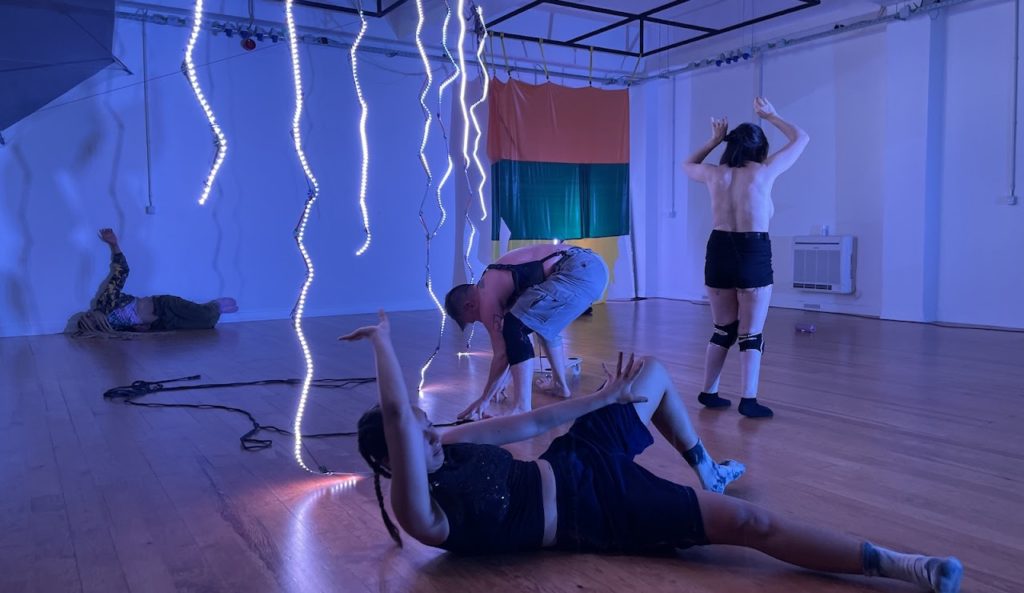pbCITEMOR2022 | Dinis Machados’ Memórias Ternas de um Afecto Queer
14th August 2022A SAGRAÇÃO DA PRIMAVERA – MEMÓRIAS TERNAS DE UM AFECTO QUEER
Dinis Machado
This text is part of various reflections from our residency at CITEMOR festival – to read more writings and reflections, including an introduction to the festival and our residency there, see here.
***
01:00, Coimbra, Portugal – Post-show conversation with Dinis at Tropical Bar
Eating: Open bag of chips
Drinking: Cervejas
“Cinco performers queer atravessam os corpos umes des outres.”
Five queer performers traverse each other’s bodies.
Iles tocam-se, arrastam-se, carregam-se, dobram-se, abandonam-se, aquecem-se, esticam-se, derretem-se, soltam-se, perfuram-se, pesam-se, esfregam-se e operam umes com os outres.”
In this text about their work Dinis describes the artists as they touch and what happens upon the type of touch they receive – resulting in dragging, bending, abandoning, heating-up, stretching, melting, releasing, perforating and weighing into each other’s bodies.
In the Portuguese text – they use an interesting characteristic in romance languages where they add the (verb)-se, a self-reflexive inflection to denote when something is done to the self/selves by the self or selves.
Tocam-se
Touch-themselves
Interestingly this doesn’t work in the same way in English, but it captures the nuances of what the intent of the work is, how it touches the boundaries of bodies on stage (and ours, as spectators) and dissolves how we relate to each other, with each other.
It felt reductive to try to apply an English-language logic to the very carefully considered and linguistically expansive text written by Dinis, so we’ve chosen to keep the Portuguese, welcome you to read the text and see how the text speaks to the grammar of movement in the work.
***
Grammar: In linguistics, the grammar of a natural language is its set of structural constraints on speakers’ or writers’ composition of clauses, phrases, and words.
How can we apply grammar to performance and diversify what we consider a performative language?
After a day of talking across languages, it was nice to consider how we can communicate across bodies. Post-show we drank a few cervejas and caught up with Dinis at a bar not far away from the venue their performance took place in and wondered about the question of touch and translation in their work and how it moves to an internal grammar devised by Dinis as the choreographic score. In Dinis’ score, a framework is created to house the tender movements between the performers and their many re-translations, the choreography itself responding to the constant back-and-forth between the performers and the different choreographic instructions set by Dinis
In their work, the grammar of the score is filled by performers and their bodies, creating vocabulary depending on their own experience and the lexicon available to the type of bodies they inhabit. All bodies on stage come from different artistic practices and cultural backgrounds. The result of this is varying as each performer translates the movements differently, and the score has to be open enough to allow for interpretation in any-body.

The piece reads like queer performance as research, as bodies explore joy and tenderness, negotiating their boundaries, their bodies and the multiplicity of movement and language as they touch each other, themselves, and the surrounding elements on stage.
This multi-layered approach to artistic language creates disparate responses both on stage and in the audience, because we don’t always know what’s going on and the negotiations between the performers are not always transparent. But not all languages need translation. We can still relate and identify ourselves in the brief moments that our own bodies connect to those on stage, even if we don’t necessarily fully understand what is being explored in front of us.
Creating new grammar and a language here also speaks to the legacies of dance and ballet and its history as a formulaic medium. What does it mean to create new forms for a piece like the Right of Spring – and to make this language accessible not just to cis-het-white people but to the bodies that have been typically excluded from dance spaces? What new configurations of this piece could we make? Where else could we take this methodology and what else could we re-translate?
For more information on Dinis Machado’s piece and body of work:
Website https://dinismachado.com/
Instagram: @dinismachado